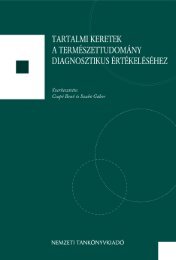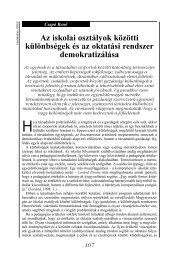értekezés - Neveléstudományi Intézet - Szegedi Tudományegyetem
értekezés - Neveléstudományi Intézet - Szegedi Tudományegyetem
értekezés - Neveléstudományi Intézet - Szegedi Tudományegyetem
You also want an ePaper? Increase the reach of your titles
YUMPU automatically turns print PDFs into web optimized ePapers that Google loves.
Schellenberg, E. G. (2006b): Long term positive associations between music lessons and IQ.<br />
Journal of Educational Psychology, 98. 2. sz. 457–468.<br />
Schellenberg, E. G. és Trainor, L. J. (1996): Sensory consonance and the perceptual similarity<br />
of complex-tone harmonic intervals: Test of adult and infant listeners. Journal of the<br />
Acoustical Society of America, 100. 3321–3328.<br />
Schellenberg, E. G. és Trehub, S. E. (1996): Natural musical intervals: Evidence from infants<br />
listeners, Psychological Science, 7. 272–277.<br />
Schlaug, G., Jäncke, L., Huang, Y. és Steinmetz, H. (1995): Increased corpus callosum size in<br />
musicians. Neuropsychologia, 33. 1047–1055.<br />
Schmithorst, V. J. és Wilke, M. (2002): Differences in white matter architecture between<br />
musicians and non-musicians: a diffusion tensor imaging study. Neuroscience Letters,<br />
321. 57–60.<br />
Schön, D., Anton, J. L., Roth, M. és Besson, M. (2002): An fMRI study of music sightreading.<br />
Neuroreport, 13. 2285–2289.<br />
Schwartz, D. L., Bransford, J. D. és Sears, D. (2005): Efficiency and innovation in transfer.<br />
In: Mestre, J. P. (szerk): Transfer of Learning: From a Modern Multidisciplinary<br />
Perspective. CT: Information Age Publishing, Greenwich. 1–52.<br />
Seashore, C. E. (1919): Measures of Music Talent. Academic Press, New York.<br />
Serafine, M. L. (1988): Music as Cognition: The Development of Thought in Sound. Columbia<br />
University Press, New York.<br />
Séra László (2004): Percepció és figyelem. In: N. Kollár Katalin és Szabó Éva (szerk.): Pszichológia<br />
pedagógusoknak. Osiris Kiadó, Budapest. 192–223.<br />
Serafine, M. L. (1988): Music as Cognition: The Development of Thought in Sound. Columbia<br />
University Press, New York.<br />
Sergent, J. (1993): Music, the Brain and Ravel. Trends of Neuroscience, 16. 168–172.<br />
Shanin, A., Roberts, L. E. és Trainor, L. J. (2004): Enhancement auditory cortical<br />
development by musical experience in children. Neuroreport, 15. 12. 1917–1921.<br />
Shaw, G. L. (2000): Keeping Mozart in Mind. Academic Press, San Diego.<br />
Shuter-Dyson (1999): Music ability. In: Deutsch, D. (szerk.): The Psychology of Music.<br />
Academic Press, London. 627–652.<br />
Silver, J. P. és Trainor, L. J. (2005): Feeleng the beat: movement influences infant rhythm<br />
perception. Science, 308. 1430.<br />
Sohn, M. H., Goode, A., Koedinger, K. R., Stenger, V. A., Fissell, K. és Carter, C. S. (2004):<br />
Behavioral equivalence, but not neural equivalence – neural evidence of alternative<br />
strategies in mathematical thinking. Nature Neuroscience, 7. 11. sz. 1193–1194.<br />
Sloboda, J. A. (1976): Visual perception of musical notation: Registering pitch symbols in<br />
memory. Quarterly Journal of Experimental Psichology, 28. 1–16.<br />
Sloboda, J. (1994): Music performance: Expression and the development of exccellence. In:<br />
Aiello, R. és Sloboda, J. (szerk.): Musical Perceptions. Oxford University Press, New<br />
York. 152–169.<br />
Sloboda, J. A., Wise, K. J. és Peretz, I.(2005): Quantifying tone deafness in the general<br />
population. Annals of the NewYork Academy of Sciences, 1060. 255–261.<br />
Snowling, M. J. (1980): The development of grapheme-phoneme correspondence in normal<br />
and dyslexic readers. Journal of Experimental Child Psychology, 29. 294–305.<br />
Spearman, C. E. (1927): The Abilities of Man, their Nature and Measurement. Macmillan,<br />
New York.<br />
296



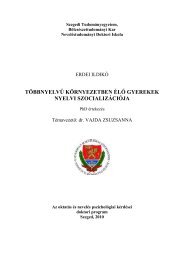

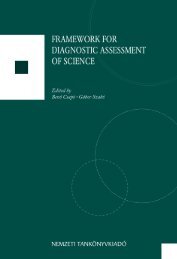
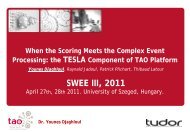
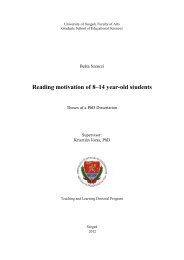

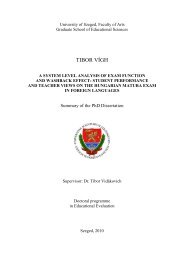
![Download [PDF] - Diagnosztikus Mérések Fejlesztése](https://img.yumpu.com/38928685/1/177x260/download-pdf-diagnosztikus-macracsek-fejlesztacse.jpg?quality=85)
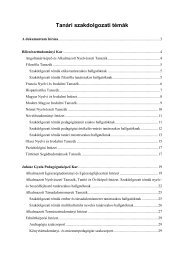
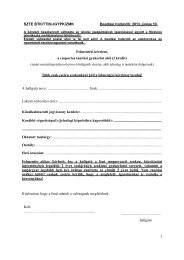
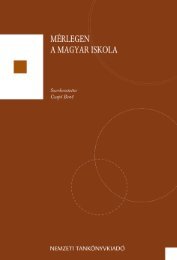
![Download [PDF] - Diagnosztikus Mérések Fejlesztése](https://img.yumpu.com/38928622/1/180x260/download-pdf-diagnosztikus-macracsek-fejlesztacse.jpg?quality=85)
